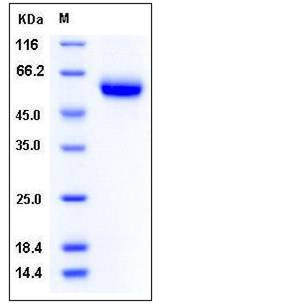Human Osteoprotegerin / TNFRSF11B Protein (His Tag)
MGC29565,OCIF,OPG,PDB5,TR1
- 100ug (NPP4134) Please inquiry
| Catalog Number | P10271-H08H |
|---|---|
| Organism Species | Human |
| Host | Human Cells |
| Synonyms | MGC29565,OCIF,OPG,PDB5,TR1 |
| Molecular Weight | The secreted recombinant human TNFRSF11B comprises 391 amino acids and has a predicted molecular mass of 45.3 kDa. As a result of glycosylation, rhTNFRSF11B migrates as an approximately 55 kDa bnd in SDS-PAGE under reducing conditions. |
| predicted N | Glu 22 |
| SDS-PAGE |  |
| Purity | > 97 % as determined by SDS-PAGE |
| Protein Construction | A DNA sequence encoding the human TNFRSF11B (NP_002537.3) (Met 1-Leu 401) was fused with a polyhistidine tag at the C-terminus. |
| Bio-activity | 1. Measured by its ability to inhibit TRAIL-mediated cytotoxicity using L-929 mouse fibroblast cells treated with TRAIL. The ED50 for this effect is typically 5-20 ng/mL in the presence of 20 ng/mL Recombinant Human TRAIL/TNFSF10 (Catalog # 10409-HNAE). 2. Measured by its binding ability in a functional ELISA. Immobilized human TNFRSF11B-His at 10 μg/ml (100 μl/well) can bind human Fc-TNFSF11 (Cat:11682-H01H) with a linear ranger of 3.125-200 ng/mL. |
| Research Area | Cardiovascular |Angiogenesis |Cytokines / Chemokines in Angiogenesis |TNF Superfamily |Processes Regulated by TNF Superfamily Members |Regulation of Apoptosis by TNF Superfamily Members | |
| Formulation | Lyophilized from sterile PBS, pH 7.4 1. Normally 5 % - 8 % trehalose, mannitol and 0.01% Tween80 are added as protectants before lyophilization. Specific concentrations are included in the hardcopy of COA. |
| Background | Osteoprotegerin or TNFRSF11B is a member of the TNF-receptor superfamily. This protein is an osteoblast-secreted decoy receptor that functions as a negative regulator of bone resorption. This protein specifically binds to its ligand, osteoprotegerin ligand, both of which are key extracellular regulators of osteoclast development. Studies of the mouse counterpart also suggest that this protein and its ligand play a role in lymph-node organogenesis and vascular calcification. Alternatively spliced transcript variants of this gene have been reported, but their full length nature has not been determined. Osteoprotegerin/TNFRSF11B acts as decoy receptor for RANKL and thereby neutralizes its function in osteoclastogenesis. This protein may inhibit the activation of osteoclasts and promotes osteoclast apoptosis in vitro. Bone homeostasis seems to depend on the local RANKL/OPG ratio. Osteoprotegerin/TNFRSF11B also play a role in preventing arterial calcification, act as decoy receptor for TRAIL and protect against apoptosis. TRAIL binding blocks the inhibition of osteoclastogenesis. |
| Reference |
